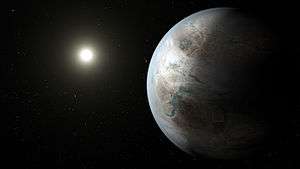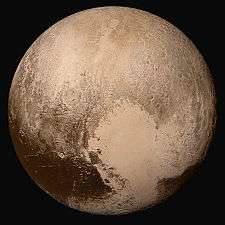Kepler-452b
| Exoplanet | List of exoplanets | |
|---|---|---|
 | ||
| Parent star | ||
| Star | Kepler-452 | |
| Constellation | Cygnus | |
| Right ascension | (α) | 19h 44m 00.89s[1] |
| Declination | (δ) | +44° 16′ 39.2″[1] |
| Apparent magnitude | (mV) | 13.426 |
| Distance | 1400 ly (430 pc) | |
| Spectral type | G2V[1][2] | |
| Mass | (m) | 1.037+0.054 −0.047[1] M☉ |
| Radius | (r) | 1.11+0.15 −0.09[1] R☉ |
| Temperature | (T) | 5757 (± 85)[1] K |
| Metallicity | [Fe/H] | 0.21 (± 0.09)[1] |
| Age | 6 (± 2)[1] Gyr | |
| Physical characteristics | ||
| Mass | (m) | 5 (± 2)[3] M⊕ |
| Radius | (r) | 1.5+0.32 −0.22[1] R⊕ |
| Stellar flux | (F⊙) | 1.11[4] ⊕ |
| Surface gravity | (g) | 1.9+1.5 −1.0 (est.) g |
| Temperature | (T) | 265 K (−8 °C; 17 °F)[1] |
| Orbital elements | ||
| Semi-major axis | (a) | 1.046+0.019 −0.015[1] AU |
| Orbital period | (P) | 384.843+0.007 −0.012[1] d |
| Inclination | (i) | 89.806+0.134 −0.049° |
| Discovery information | ||
| Discovery date | 23 July 2015 (announced) | |
| Discoverer(s) | Kepler Science Team | |
| Discovery method | Transit | |
| Discovery site | Kepler | |
| Discovery status | Published | |
| Other designations | ||
| KOI-7016.01[5] | ||
| Database references | ||
| Extrasolar Planets Encyclopaedia | data | |
| SIMBAD | data | |
| Exoplanet Archive | data | |
| Open Exoplanet Catalogue | data | |
Kepler-452b (sometimes nicknamed Earth 2.0 or Earth's Cousin[6][7] based on its characteristics; known sometimes as Coruscant by NASA,[8] also known by its Kepler Object of Interest designation KOI-7016.01) is an exoplanet orbiting the Sun-like star Kepler-452 about 1,400 light-years (430 pc) from Earth in the constellation Cygnus. It was identified by the Kepler space telescope, and its discovery was announced by NASA on 23 July 2015.[2] It is the first potentially rocky super-Earth[4] planet discovered orbiting within the habitable zone of a star very similar to the Sun.[9]
The planet is about 1,400 light-years away from the Solar System. At the speed of the New Horizons spacecraft, about 59,000 km/h (37,000 mph), it would take approximately 26 million years to get there.[10]
Characteristics
Mass, radius and temperature
Kepler-452b has a probable mass five times that of Earth, and its surface gravity is twice Earth's, though calculations of mass for exoplanets are only rough estimates.[11] If it is a terrestrial planet, it is most likely a super-Earth with many active volcanoes due to its higher mass and density. The clouds on the planet would be thick and misty, covering much of the surface as viewed from space.
The planet takes 385 Earth days to orbit its star.[12] It is 50% bigger than Earth, and lies within the conservative habitable zone of its parent star.[11][13] It has an equilibrium temperature of 265 K (−8 °C; 17 °F), a little warmer than Earth.
Host star
The host star, Kepler-452, is a G-type star that is about the same mass of the Sun, only 3.7% more massive and 11% larger. It has a surface temperature of 5757 K, nearly the same as the Sun, which has a surface temperature of 5778 K.[14] The star's age is estimated to be about 6 billion years old, about 1.6 billion years older than the Sun, which is 4.6 billion years old.[15] From the surface of Kepler-452b, its star would look almost identical to the Sun as viewed from the Earth.[16]
The star's apparent magnitude, or how bright it appears from Earth's perspective, is 13.426. Therefore it is too dim to be seen with the naked eye.
Orbit
Kepler-452b orbits its host star with about 20% more of the Sun's luminosity (1.2 L☉) with an orbital period of 385 days and an orbital radius of about 1.04 AU, nearly the same as Earth's (1 AU).
Habitability potential
It is not known if Kepler-452b is a rocky planet[6] but based on its small radius, Kepler-452b is likely rocky.[2] It is not clear if Kepler-452b offers habitable environments. It orbits a G2V-type star, like the Sun, with nearly the same temperature and mass and 20% more luminous.[12] However, the star is six billion years old, making it 1.5 billion years older than the Sun. At this point in its star's evolution, Kepler-452b is receiving 10% more energy from its parent star than Earth is currently receiving from the Sun.[9] If Kepler-452b is a rocky planet, it may be subject to a runaway greenhouse effect similar to that seen on Venus.[17] However, due to the planet being 50% bigger than Earth, it is likely to have an estimated mass of 5 M⊕, which could prevent Kepler-452b from succumbing to the runaway greenhouse effect for another 500 million years, thus holding on to any oceans it may have for a longer period time compared to when Earth's oceans dry up.[17] This in turn would be accompanied with the carbonate–silicate cycle being "buffed" in duration due to increased volcanic activity on Kepler-452b.[18] This could allow any potential life on the surface to continue to evolve for another 500–900 million years before the habitable zone is pushed out of Kepler-452b's orbit.[19]
Discovery and follow-up studies
In 2009, NASA's Kepler spacecraft was observing stars on its photometer, the instrument it uses to detect transit events, in which a planet crosses in front of and dims its host star for a brief and roughly regular period of time. In this last test, Kepler observed 50000 stars in the Kepler Input Catalog, including Kepler-452; the preliminary light curves were sent to the Kepler science team for analysis, who chose obvious planetary companions from the bunch for follow-up at observatories. Observations for the potential exoplanet candidates took place between 13 May 2009 and 17 March 2012. After observing the respective transits, which for Kepler-452b occurred roughly every 385 days (its orbital period), it was eventually concluded that a planetary body was responsible for the periodic 385-day transits. The discovery was announced on July 23, 2015 in an announcement made by NASA.[2]
At nearly 1,400 light-years (430 pc) distant, Kepler-452b is too remote and its star too far for current telescopes or the next generation of planned telescopes to determine its true mass or whether it has an atmosphere. The Kepler spacecraft focused on a single small region of the sky but next-generation planet-hunting space telescopes, such as TESS and CHEOPS, will examine nearby stars throughout the sky. Nearby stars with planets can then be studied by the upcoming James Webb Space Telescope and future large ground-based telescopes to analyze atmospheres, determine masses and infer compositions. Additionally the Square Kilometer Array would significantly improve radio observations over the Arecibo Observatory and Green Bank Telescope.[20]
SETI targeting
Scientists with the SETI (Search for Extraterrestrial Intelligence) Institute have already begun targeting Kepler-452b, the first near-Earth-size world found in the habitable zone of a Sun-like star.[21] SETI Institute researchers are using the Allen Telescope Array, a collection of 6-meter (20 feet) telescopes in the Cascade Mountains of California, to scan for radio transmissions from Kepler-452b. As of July 2015, the array has scanned the exoplanet on over 2 billion frequency bands, with no result. The telescopes will continue to scan over a total of 9 billion channels, searching for alien radio signals.[21]
Observation and exploration
The fact that Kepler-452b is 1,400 light years from Earth, and light travels 5.88 trillion miles in a year, means it would take the best part of a millennium-and-a-half to reach it if a spacecraft could travel at the speed of light.[7] The speed of light is 668,000,000 mph (1.075×109 km/h; 186,000 mi/s) and the fastest current space craft, the New Horizons unmanned probe that passed Pluto in July 2015, travels at just 35,187 mph (56,628 km/h).[7] At this rate, it would take the craft about 26 million years before it reached Kepler-452b, clearly an unthinkable amount of time.[7]
| Notable Exoplanets – Kepler Space Telescope |
|---|

|
Gallery
|
See also
References
- 1 2 3 4 5 6 7 8 9 10 11 12 "NASA Exoplanet Archive – Confirmed Planet Overview – Kepler-452b". NASA Exoplanet Archive. 2015. Retrieved 23 July 2015.
- 1 2 3 4 Jenkins, Jon M.; Twicken, Joseph D.; Batalha, Natalie M.; et al. (23 July 2015). "Discovery and Validation of Kepler-452b: A 1.6 R⨁ Super Earth Exoplanet in the Habitable Zone of a G2 Star" (PDF). The Astronomical Journal. 150 (2): 56. arXiv:1507.06723
 . Bibcode:2015AJ....150...56J. doi:10.1088/0004-6256/150/2/56. ISSN 1538-3881. Retrieved 24 July 2015.
. Bibcode:2015AJ....150...56J. doi:10.1088/0004-6256/150/2/56. ISSN 1538-3881. Retrieved 24 July 2015. - ↑ "NASA's Kepler Mission Discovers Bigger, Older Cousin to Earth". National Aeronautics and Space Administration. July 23, 2015. Retrieved June 10, 2016.
- 1 2 "The Habitable Exoplanets Catalog – Planetary Habitability Laboratory @ UPR Arecibo". upr.edu.
- ↑ Johnson, Michele (23 July 2015). "Twelve New Small Kepler Habitable Zone Candidates". NASA. Retrieved 24 July 2015.
- 1 2 Rincon, Paul (23 July 2015). "'Earth 2.0' found in Nasa Kepler telescope haul". BBC News. Retrieved 24 July 2015.
- 1 2 3 4 Kepler-452b: How long would it take humans to reach 'Earth 2' and could we live there?
- ↑ Pat Brennan (15 December 2015). "8 planets that make you think Star Wars is real". NASA. Retrieved 26 July 2016.
- 1 2 Chou, Felicia; Johnson, Michele (23 July 2015). "NASA's Kepler Mission Discovers Bigger, Older Cousin to Earth" (Press release). NASA. Retrieved 23 July 2015.
- ↑ "NASA telescope discovers Earth-like planet in star's 'habitable zone". BNO News. 23 July 2015. Retrieved 23 July 2015.
- 1 2 Feltman, Rachel (23 July 2015). "Scientists discover 12 new potential Earth-like planets". The Washington Post. Retrieved 23 July 2015.
- 1 2 Overbye, Dennis (23 July 2015). "Kepler Data Reveals What Might Be Best 'Goldilocks' Planet Yet". The New York Times. Retrieved 23 July 2015.
- ↑ Witze, Alexandra (23 July 2015). "NASA spies Earth-sized exoplanet orbiting Sun-like star". Nature. Retrieved 23 July 2015.
- ↑ Fraser Cain (15 September 2008). "Temperature of the Sun". Universe Today. Retrieved 19 February 2011.
- ↑ "Planet HIP 11915". Retrieved 17 July 2015.
- ↑ NASA Kepler press conference. 23 July 2015.
- 1 2 Lugmayr, Luigi (23 July 2015). "Kepler-452b details unveiled". I4U News. Retrieved 23 July 2015.
- ↑ "Is Earth's Closest Cousin A Dying Planet?". Gizmodo.com. July 30, 2015. Retrieved May 24, 2016.
- ↑ "Kepler-452b - Similarty to Earth - Check123, Video Encyclopedia". Check123 - Video Encyclopedia. Retrieved 2016-09-29.
- ↑ Siemion, Andrew P.V.; Demorest, Paul; Korpela, Eric; Maddalena, Ron J.; Werthimer, Dan; Cobb, Jeff; Langston, Glen; Lebofsky, Matt; Marcy, Geoffrey W.; Tarter, Jill (3 February 2013). "A 1.1 to 1.9 GHz SETI Survey of the Kepler Field: I. A Search for Narrow-band Emission from Select Targets". Astrophysical Journal. 767: 94. arXiv:1302.0845
 . Bibcode:2013ApJ...767...94S. doi:10.1088/0004-637X/767/1/94.
. Bibcode:2013ApJ...767...94S. doi:10.1088/0004-637X/767/1/94. - 1 2 SETI Targets Kepler-452b, Earth's 'Cousin,' in Search for Alien Life
External links
| Wikimedia Commons has media related to Kepler-452b. |
- NASA – Kepler Mission
- NASA – Kepler Discoveries – Summary Table
- Habitable Exolanets Catalog at UPR-Arecibo.
- Discovery and Validation of Kepler-452b: A 1.6 R⨁ Super Earth Exoplanet in the Habitable Zone of a G2 Star
Coordinates: ![]() 19h 44m 00.89s, +44° 16′ 39.2″
19h 44m 00.89s, +44° 16′ 39.2″




